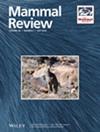Differential climatic niche diversification processes in South American rodents (Octodontoidea) across tropical and extratropical regions
IF 4.4
2区 生物学
Q1 ECOLOGY
引用次数: 0
Abstract
- Studying niche evolution becomes central to understanding the processes driving species diversification along latitudinal gradients. Octodontoidea rodents serve as a model group for understanding how the colonisation of extratropical regions has shaped the climatic niche evolution of species.
- We analyse the time and mode of climatic niche evolution among different Octodontoidea lineages to understand how niche evolutionary processes operate across the spatial gradient of the Neotropical region.
- We constructed ecological niche models for living Octodontoidea species to assess the timing and mode of climatic niche evolution across tropical and extratropical lineages. We estimated niche similarity and correlated it with species divergence times, and estimated the rate of climatic niche diversification across lineages.
- Our results show a trend of greater niche overlap in more recent lineages and lower niche overlap in older lineages. However, extratropical lineages exhibit lower climatic niche overlaps. From diversification analysis, we detected that the Ctenomyidae group shows higher rates of niche diversification, whereas the tropical Echimyidae group exhibits the lowest rates of climatic niche diversification.
- Our results support the idea that the lineages restricted to tropical regions tend towards niche conservatism. However, some tropical lineages have successfully colonised extratropical regions, and this colonisation has been accompanied by strong selective pressures, leading to higher rates of niche diversification and lower climatic niche overlap among species.
热带和温带地区南美啮齿动物(八齿动物总科)不同气候生态位多样化过程
研究生态位进化对于理解沿纬度梯度驱动物种多样化的过程至关重要。八齿目啮齿类动物可以作为理解温带地区的殖民化如何影响物种气候生态位进化的模型群。我们分析了不同八齿兽谱系间气候生态位演化的时间和模式,以了解生态位演化过程在新热带地区的空间梯度上是如何运作的。我们构建了八齿纲物种的生态位模型,以评估热带和温带谱系气候生态位演化的时间和模式。我们估计了生态位相似性,并将其与物种分化时间相关联,并估计了不同谱系间气候生态位多样化的速率。结果表明,在较近的世系中,生态位重叠较大,而在较老的世系中,生态位重叠较小。然而,温带谱系表现出较低的气候生态位重叠。从生态位多样化分析中,我们发现毛线虫科的生态位多样化率较高,而热带针蚜科的生态位多样化率最低。我们的研究结果支持了局限于热带地区的谱系倾向于生态位保守的观点。然而,一些热带谱系已经成功地殖民了温带地区,这种殖民化伴随着强大的选择压力,导致物种间生态位多样化率更高,气候生态位重叠率更低。
本文章由计算机程序翻译,如有差异,请以英文原文为准。
求助全文
约1分钟内获得全文
求助全文
来源期刊

Mammal Review
生物-动物学
CiteScore
12.20
自引率
4.10%
发文量
29
审稿时长
>12 weeks
期刊介绍:
Mammal Review is the official scientific periodical of the Mammal Society, and covers all aspects of mammalian biology and ecology, including behavioural ecology, biogeography, conservation, ecology, ethology, evolution, genetics, human ecology, management, morphology, and taxonomy. We publish Reviews drawing together information from various sources in the public domain for a new synthesis or analysis of mammalian biology; Predictive Reviews using quantitative models to provide insights into mammalian biology; Perspectives presenting original views on any aspect of mammalian biology; Comments in response to papers published in Mammal Review; and Short Communications describing new findings or methods in mammalian biology.
 求助内容:
求助内容: 应助结果提醒方式:
应助结果提醒方式:


